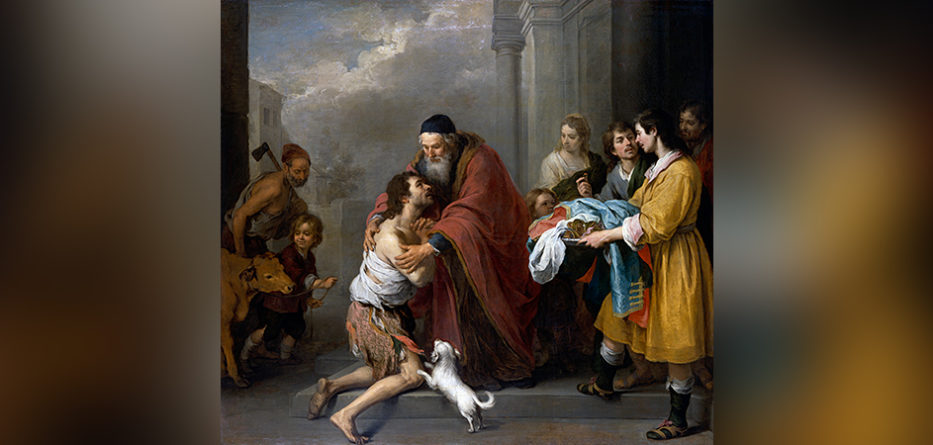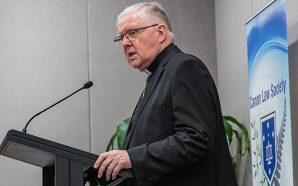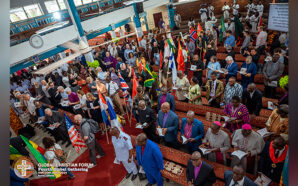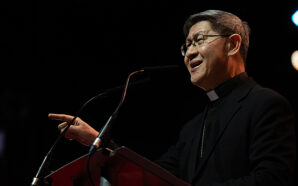Fourth Sunday of Lent
Readings: Joshua 5:9-12; Psalm 33(34):2-7; 2 Corinthians 5:17-21; Luke 15:1-3, 11-32
Sunday 27 March 2022
Breaking Open the Word
In the parable of the prodigal son, the younger son asks for his share of the property and leaves for a distant country where he squanders his money on a life of debauchery. A severe famine hits and he experiences physical hunger, an emptiness within his stomach that needs to be filled. Given the chance, he would have filled it with rubbish—the husks the pigs were eating. Finally, he came to his senses and returned to his father. It is not sorrow for what he has done that turns him back to his father, it is hunger that leads him home.
In our own lives, there are moments when we drift away from God and from the Father’s house. There are moments when we experience spiritual hunger—a darkness or an emptiness within us, within the human heart and soul—that needs to be filled. But instead of turning to God, we often fill this emptiness with rubbish. We turn to other things for comfort, things that are of an addictive nature, and we often fall back into old ways and habits of sin. But soon we are left feeling hungry again, and that darkness and emptiness within the soul is greater than ever before.
Why are we so slow to turn to God? In some ways, it is like the prayer of St Augustine: “Give me chastity and continence, but not for a while” (Confessions, Bk 8, Ch 7), or, “Lord, help me to be a better person, but not yet”—not until you have shown me the alternative, not until you have shown me what is on offer, because there is a darkness within me, an emptiness within my heart and soul that needs to be filled, and until I know and experience how you, dear Lord, are going to fill that emptiness, at least I find some comfort in the things of this world; at least those bad habits and sins and things of an addictive nature fill that emptiness within me, even if only for a short while, and even if only to a certain extent.
But before long, I am left feeling hungry again, longing for something or someone to fill that emptiness within. And so, there must come a time in my life when, like the prodigal son, I also come to my senses, recognising that the darkness and emptiness within my heart and soul is actually infinite, and can therefore only be filled by our infinite God. It is not necessarily sorrow and guilt that turns us back to God, it is hunger—the realisation that without God in my life there is something missing.
And yet, still I hesitate to turn to God. Like the prodigal son, there is a fear of being judged and rejected, a fear of being turned away by God, which is why the son plans a speech in which he even proposes that he be treated as a paid servant, if only he be allowed back in. Where does this fear of God come from? Perhaps it is from our own human experiences of being judged by others and rejected by people we love. Perhaps it is also one of the terrible consequences of sin.
Sin does not change God. God is still the God of love, mercy and compassion. Sin changes us in that it distorts our image of God. When Adam and Eve ate the forbidden fruit of sin, their eyes were opened to a new and distorted way of seeing things, they became afraid of God and tried to hide from God (Gn 3:7–8), having developed a twisted and distorted image of God, believing God to be angry and vengeful, whose only desire is to punish us. But the parable of the prodigal son reminds us that God has not changed. The compassionate father is moved with pity, runs to meet his child and brings him the rest of the way home.
Fr Antony Jukes OFM
Artwork Spotlight for personal reflection
The Return of the Prodigal Son (c. 1667–1670) – Bartolomé Esteban Murillo (1617–1682)
The Return of the Prodigal Son (c. 1667–1670). Oil on Canvas, 236 × 262 cm. National Gallery of Art, Washington D.C., USA. Public Domain
The Return of the Prodigal Son was one of eight huge canvases painted for the chapel of the hospital of St George in Seville—a hospice for the homeless and hungry. It was run by the Brotherhood of Charity, one of Seville’s lay confraternities. The Caridad (or Caritas), as it was known, was founded in 1565 with the mission of providing a decent funeral for paupers. It was then expanded to provide care for the sick. Murillo’s paintings of the acts of mercy, installed on the walls of the chapel, are recognised as among his greatest.
In The Return of the Prodigal Son, which represents the clothing of the naked, Murillo emphasises the protective embrace of the forgiving father. The parable in St Luke’s Gospel, and so typical of St Luke who virtually repeats the scene in the forgiveness of the good thief on the cross, is a paradox of justice. In worldly terms, justice would seem to be served in condemning the lost son and sending him away again. After all, he had publicly insulted his parents (interestingly, the mother appears in this painting standing behind the father.) By demanding his inheritance, and thus wishing his father dead, the younger son repudiated the family home—the very heart of Eastern society. And in the days before pensions and social services, it was a son’s strict duty to support his parents in their old age. Having squandered his share on the bright lights, the younger son would no longer be able to do this—handing on the entire responsibility to his elder brother.
The father is prepared to even make a public fool of himself in the eyes of his neighbours by running down the road to receive his son, not even waiting to hear the apology. Jesus is stating most clearly that God is always ready to forgive, showing a justice which goes far beyond our societal justice. In fact, Jesus’ listeners would have been shocked. In comment, Benedict XVI writes: “Because God is God, the Holy One, he acts as no man could act. God has a heart, and his heart turns, so to speak, against God himself” (Jesus of Nazareth, Illustrated Edition, 216). In other words, when it comes to mercy and forgiveness, God cannot help himself.
Now, remember where this painting was situated. It was in a hospital for the poor and abandoned, among whom were probably the worst of criminals. What a message of infinite hope, perhaps even for Murillo himself. He had lost his parents at a young age, and for all his public success, may well have experienced moments of abandonment.
In an ironic twist, the joy of the scene is almost typified by the little dog pawing at his returned master’s leg, trying to attract his attention. The animal would have no inkling of the complexities of the scene, just unmitigated joy. It is shown, too, on the face of a small boy on the left-leading the fattened calf for the coming feast. And the father’s forgiveness is not just words. On the right are two servants, one holding a ring (the boy’s authority is to be returned to him), the other, “the best robe” (Lk 15:22).
And is it the elder son peering out of the shadows on the extreme right not wanting to join in the celebration? The father’s extravagant love moves him to make a fool of himself once again. In full view of his guests, he leaves the party and goes out to beg his son to come in. Is the Father not only inviting us, but even begging us, to come back to him this Lent? St Paul takes up this pleading invitation when he writes: “We beg you on behalf of Christ, be reconciled to God” (2 Cor 5:20).
It would have been wonderful to see the whole series Murillo painted for this chapel. Seven paintings are now in the National Gallery of Ireland, with The Return of the Prodigal Son in the National Gallery of Art in Washington. The other themes included the prodigal son receiving his portion, the departure, the testing (in the far-off country), feeding the swine, and the prodigal son driven out (penniless). Murillo’s paintings are full of real people from real life, for he painted what he saw in the city. Catholic Spain would have viewed some of his work as boldly revolutionary. By the time of his death in 1682, Murillo had produced more than 400 paintings, cementing a legacy that has endured to the present, and making his work a magnet for collectors, top museums, and art thieves.
Mgr Graham Schmitzer
Fr Antony Jukes OFM was raised in a Catholic family in Chingford, East London (the second of six children.) He was an altar server at his parish for many years, but found himself drifting from his faith during his years at university. After completing his studies, he worked as a trainee-chartered accountant in central London. It was on a pilgrimage to the shrine of Our Lady of Lourdes (France) that led him to rediscover his love for his Catholic faith and to question his vocation. His devotion to St Antony of Padua, after whom he was named, and his love for St Francis of Assisi, led him to join the Franciscan Order of Friars Minor in 2002. He studied philosophy and theology at what was the Franciscan International Study Centre in Canterbury, England, before being ordained a priest in 2009. Having served in a parish and in a youth retreat centre, Fr Antony is now the novice director at the international novitiate community in Killarney, Ireland.
Mgr Graham Schmitzer is a retired parish priest in the Diocese of Wollongong. He was ordained in 1969 and has served in the parishes of Campbelltown, Gwynneville, Unanderra, Wollongong, Albion Park, and Corrimal. He was also chancellor and secretary to Bishop William Murray for 13 years. He grew up in Port Macquarie and was educated by the Sisters of St Joseph of Lochinvar, completing his leaving certificate at Wauchope High School. For two years he worked for the Department of Attorney General and Justice before entering St Columba’s College, Springwood, in 1962. Fr Graham loves travelling and has visited many of the major art galleries in Europe.
With thanks to the Diocese of Wollongong, who have supplied these weekly Lenten 2022 reflections from their publication, Remember – Lenten Program 2022.








